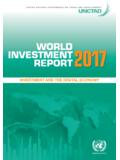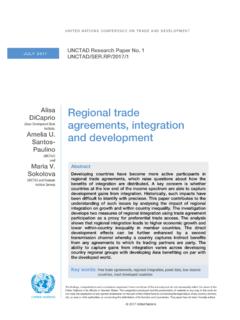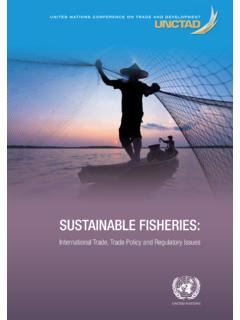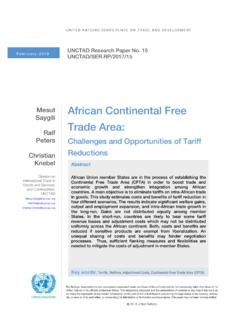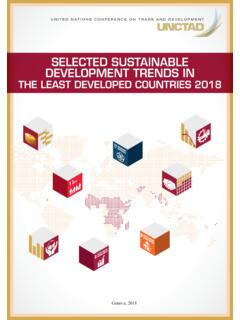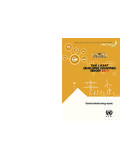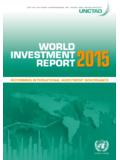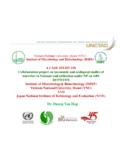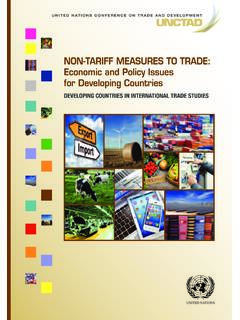Transcription of TEA UNCTAD INFOCOMM
1 TEA UNCTAD INFOCOMM 1 UNITED NATIONS CONFERENCE ON TRADE AND DEVELOPMENT TEA An INFOCOMM Commodity Profile UNCTAD Trust Fund on Market Information on Agricultural Commodities New York and Geneva, 2016 TEA UNCTAD INFOCOMM 2 Notes INFOCOMM is an extra-budgetary project funded by the Government of France. This multilingual information sharing platform was developed by UNCTAD in 2000 in response to the scarcity of commodity market information in commodity dependent developing countries. INFOCOMM disseminates free and up-to-date commodity profiles of selected agricultural products in three languages: English, French and Spanish. This commodity profile has been written by Ms Neema Toyb, consultant, under the overall guidance of Samuel Gayi, Head of the Special Unit on Commodities (SUC), and the supervision of Yanchun Zhang, Chief of the Commodities Policy Implementation and Outreach Section, SUC.
2 Dani le Boglio and Branko Milicevic prepared the text for publishing. The profile has not been formally edited. Disclaimer The designations employed and the presentation of the material do not imply the expression of any opinion on the part of the United Nations concerning the legal status of any country, territory, city or area, or of authorities or concerning the delimitation of its frontiers or boundaries. Material in this publication may be freely quoted or reprinted, but acknowledgement is requested, together with a copy of the publication containing the quotation or reprint to be sent to the UNCTAD secretariat at: UNCTAD , Palais des Nations, CH-1211 Geneva, Switzerland. Contacts For further information on the Special Unit on Commodities, please contact us at: UNCTAD 's Special Unit on Commodities Palais des Nations 8 14, Avenue de la Paix 1211 Geneva 10 Switzerland Phone: +41 22 917 1648 / 6286 Fax: +41 22 917 0509 Email: Website: Symbol of this document TEA UNCTAD INFOCOMM 3 1.
3 Overview Description Figure 1: Tea plant Source:Camelilia Sinensis, Franz Eugen K hler, K hler's Medizinal-Pflanzen, 1897 Scientific name: Camellia sinensis Family: Theaceae Common name: Tea, tea bush, cha, chai Leaves: Bright green and shiny Flowers: Scented, occurring singly or in clusters of two to four. Fruits: Brownish-green, containing one to four spherical or flattened seeds. Origin: Native to East, South and Southeast Asia, but it is today cultivated across the world in tropical and subtropical regions. TEA UNCTAD INFOCOMM Origins; early trade history The story of tea starts in China in 2737 BC. China is considered to be the source of the indigenous tea plant and the birthplace of the first tea gardens. According to the legend, the Chinese and renowned herbalist Shen Nung, was sitting under a tree while his servant boiled drinking water, when few leaves from the tree blew into it.
4 The emperor was then attracted by the pleasant fragrance rising from the steaming infusion. The tree was a Camellia Sinensis, and the brew that was accidentally created was the tea beverage. Tea was one of the commodities that was a part of colonial trading. While the Portuguese were the first to trade tea in the Far East, the Dutch spread the consumption of tea in the West, both in their colony and in their home country. The custom of drinking tea quickly spread to France, Germany and later to Great Britain. Tea has achieved popularity in other parts of the world only since the middle of the 17th century. Commercial cultivation of tea gradually expanded to India, Indonesia, and Sri Lanka until the middle of the 19th century. The first record of cultivation of tea in Africa was in 1850; Commercial production in Africa started in former British colonies such as Kenya, Tanzania and Malawi.
5 However, the tea industry developed until the middle of the 20th century. Now, tea plants are distributed worldwide and grown commercially in tropical, subtropical and temperate climatic regions of Asia, Africa and South America, and in limited areas in North America, Europe and Australia. Cultivation; harvesting; processing; transportation to consumer Tea is a perennial crop. Recently planted tea bushes need at least three years to attain maturity and start yielding green leaves for manufacture. The economic life of the plant is about 40 years, but sometimes the shrubs are kept in production 60 -70, or even 100 years. The life of the tea bush is more than 100 years as its economic age. However, it depends upon the type of tea plant, climatic conditions and the care received from the growers during the lifetime.
6 The geography and setting of tea plantations worldwide show marked differences in terrain and climate which result in the different qualities displayed from various sources. Tea production is geographically restricted to a few areas around the world and it is highly sensitive to variations in growing conditions. The chemical composition of the tea plant changes in response to the different growing condition, and during processing. The tea plant has to grow in a broad range of conditions. - Tea can grow from subtropical climates to tropical climates, but generally requires a fair amount of humidity and rainfall during the growing season. - Altitude is one of the key influencers of climate. With a higher elevation and temperatures become more variable, rainfall generally becomes higher.
7 Tea soils must be acid. - The seasonality of precipitation is important in affecting the quality of tea, and tea leaves harvested at different times will produce a finished product with different characteristics. Growing and harvesting of tea Throughout history, there have been various methods of tea growing and harvesting. Nowadays, in light of modern scientific evidences and the complexities of tea, its cultivation and harvesting have more or less been standardized across the world. The growth cycle is from 240 to 365 days, fruits takes from 270 to 360 days to mature and seeds are normally produced after 3 years. The young plants that have been carefully nurtured in nurseries for up to a year are re-planted in especially prepared fields following the natural reliefs of the land, or sometimes, on specially prepared terraces to help irrigation and to prevent erosion.
8 The plants are planted 3 to 5 feet (1 to meters) apart. It takes approximately two to three TEA UNCTAD INFOCOMM 5 years, depending on the elevation and climatic conditions, before these plants are ready to produce tea. Pruning When the young plant develops to a height of about half a meter above ground level, it is cut back to within a few inches off the ground to develop it into a flat-topped bush. Once fully developed, a tea bush is approximately 3 feet (1 m) in height, and continues to be pruned in cycles of 1-2 years at low altitude and 3-5 years at higher altitudes. The timing of pruning also dependent on the rainfall, as sufficient moisture in the soil is required. Plucking or Picking Plucking consists of harvesting fresh young shoots from the mature tea bushes. Tea shoots are picked, which generally named as plucking.
9 A tea shoot at the correct maturity for the manufacture of high quality made tea, comprises of an unfurled bud with two or three soft leaves. 10 kg of green shoots (75-80% water) produce about kg of dried tea. Optimum yield is about t/ha1. Quality and biochemical constituents of tea leaves depends on the method of harvesting. Tea-plucking is done manually (hand-plucking) or with machine (automated picking). However, hand-plucking remains the best method of tea harvesting. Automated picking is a non-selective process, which can damage the leaves and affect the quality. Tea Processing As soon as the newly picked leaves reach the factory, processing begins. Tea processing is the method in which the leaves from the tea plant are transformed into the dried leaves for brewing tea.
10 The categories of tea are distinguished by the processing they undergo. Tea processing involves different manners and degree of oxidation of the leaves, ending the oxidation, forming the tea and drying it. Tea processing for all tea types consists of very similar traditional methods with only minor 1 Source: Fao Ecocrop,(code 599) variations. They main different steps are the following: The whitering: Tea leaves begin to wilt soon after plucking, with a gradual beginning of enzymatic oxidation. This process is called withering, and is used to eliminate excess water from the leaves and allow slight oxidation. Cold or warm air is blown through the leaf for 12 to 18 hours. Maceration: Teas are bruised or torn in order to promote and accelerate oxidation.
